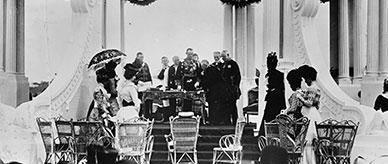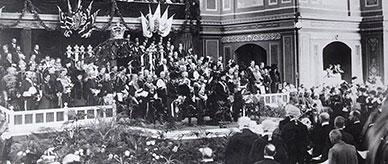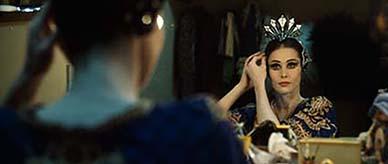


About this record
This hand-coloured perspective sketch of the view from Mount Ainslie is on three silk panels and depicts Walter Burley Griffin's 1912 winning design for Canberra. On the two outer panels is a rectangular block with text. The left panel has the words 'Commonwealth of Australia / Federal Capital Competition' and the right panel the words 'View from Summit of Mount Ainslie'. The central panel, comprising the largest section of the sketch, portrays the main part of the Griffins’ plan for Canberra.
Educational value
- This work forms part of entry no. 29, the winning entry for the 1911 Australian Federal Capital City Design Competition, prepared by architects Walter Burley Griffin (1876–1937) and Marion Mahony Griffin (1871–1961).
- This image is an example of Marion Mahony Griffin's skills as an architect and architectural illustrator, talents that had seen her take on a leading role in the Prairie School of architecture and design in the United States. The importance of her sketches in influencing the judging panel has recently been more fully recognised. It is now thought these finely detailed and beautifully rendered illustrations significantly contributed to the ultimate success of the Griffin entry.
- Marion Mahony Griffin's drawings display her precise, inventive and complex technique. The first drawings were in ink on linen tracing cloth, which was then lithographed onto Holland cloth before being rendered with watercolours and photographic dyes. After being lithographed again onto satin, the drawings were sized (sealed) and stretched. They were then re-rendered. Finally, they were dusted and some of the size was removed to reveal the satin surface beneath.
- The image shows some of the elements the Griffins incorporated into their design for the new capital, particularly the use of large bodies of water and radiating axes with a civic centre. The design was based on the shapes of the existing physical landscape, including the mountains, of which Mount Ainslie was particularly important. The land axis leading from this mountain helped delineate the overall formation of the city along geometric lines.
- The Griffin plans were changed, both before and during the construction of Canberra, but arguably the key elements of their design can be discerned today. The radiating axes drawn from the area's natural features guided the layout of the city and siting of key roads such as Commonwealth Avenue, Constitution Avenue and Kings Avenue.
- Entrants to the 1911 Federal Capital City Design Competition were required to take account of the landscape setting. All of the design work by the Griffins in Australia demonstrates their appreciation of nature and interest in local environments, including this image.
Acknowledgments
Learning resource text © Education Services Australia Limited and the National Archives of Australia 2010.
Related themes
Need help with your research?
Learn how to interpret primary sources, use our collection and more.



